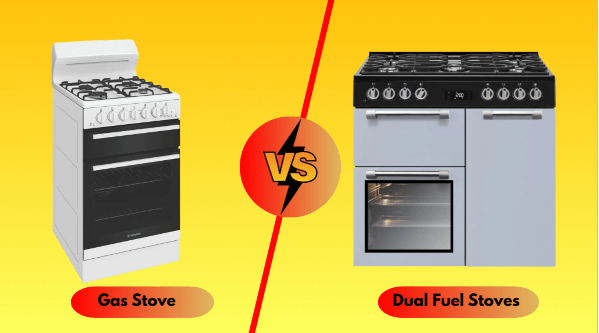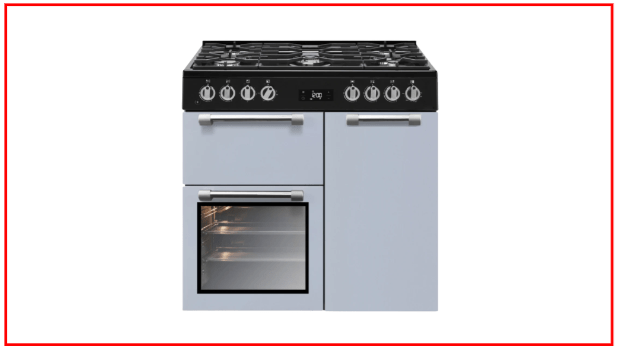Introduction
Picture this: you’re ready to upgrade your kitchen, and the stove is the star of the show. But here’s the catch—do you go for a trusty gas stove or hunt down dual fuel stoves? Both have their fans, and both promise to make your cooking dreams come true. You might be a stovetop wizard who enjoys adjusting flames. Or maybe you’re a baking buff aiming for perfect oven results. Whatever your style, picking the right stove can feel like a big decision. Lucky for you, we’re here to break it down—gas stoves vs dual fuel stoves, head-to-head. By the end, you’ll know exactly which one fits your kitchen and your vibe. No techie jargon, just the good stuff to help you choose with confidence. Ready to find your cooking soulmate? Let’s dive in and figure out whether a gas stove or those tempting dual fuel stoves deserve a spot in your home.
What Are Gas Stoves?
So, what’s the deal with a gas stove? It’s the classic choice you’ve likely seen in action—imagine flames swirling beneath pots and pans. A gas stove operates using only natural gas or propane, providing energy to both the burners and the oven. It’s like having a mini campfire in your kitchen, but way more controlled. The big win? You can adjust the heat without delay. Want a roaring flame for a quick sear? Done. Need a gentle simmer? Just twist the knob.
People love a gas stove for its speed and precision. It heats up quickly, cools down within a brief period, and is affordable to purchase. If you’re into wok cooking or flipping pancakes with flair, this might be your pick. Plus, installation is usually simple—just hook it to a gas line, and you’re good to go. But it’s not perfect. The oven can be a little uneven, so your cookies might not all come out the same. And if your power’s out, you’re still cooking—assuming you’ve got a match to light it.
Gas stoves are everywhere because they’re reliable and affordable. They’ve been the go-to for home cooks and pros alike. So, if you’re eyeing a gas stove, you’re in good company—it’s a solid choice for anyone who loves that hands-on cooking feel. But how does it stack up against those dual fuel stoves? Let’s find out.
What Are Dual Fuel Stoves?
Now, let’s talk about dual fuel stoves. These are the kitchen’s hybrid heroes. They blend gas and electric power for the best of both worlds. Here’s how it works: the cooktop uses gas burners, just like a gas stove, so you still get that instant flame control. But the oven? That’s electric, giving you steady, even heat that bakers dream about.
Why go for dual fuel stoves? It’s all about versatility. You can sear a steak with precision on the gas burners, then pop a cake in the oven and trust it’ll rise just right. The electric oven is a game-changer—fewer hot spots, more consistency. If you’re the type who loves a golden roast or pastries with a perfect puff, this could be your match. Dual fuel stoves often come with stylish designs and cool features. They can make a significant impression in your kitchen.
The catch? They cost more than a regular gas stove. You need a gas line and a strong electrical hookup—240 volts, not a standard plug. So, setup is a bit more involved. Still, for folks who want flexibility, dual fuel stoves are hard to beat. They’re like having two superpowers in one appliance. But is that extra oomph worth it? Let’s put them side by side and see.
Key Differences Between Gas and Dual Fuel Stoves
Time for the main event: gas stove versus dual fuel stoves. What’s the real difference? Let’s break it down. A gas stove is all in on gas—burners and oven run on the same fuel. Dual fuel stoves split the job: gas up top, electric below. That’s the core twist, and it changes everything.
On the cooktop, both give you gas burners, so you’re flipping flames like a pro either way. A gas stove keeps it simple and fast—great for boiling water or frying up dinner. Dual fuel stoves match that speed on top, but their electric oven steals the show. It heats in a way that prevents your lasagna from burning on one side. A gas stove’s oven? It might be a little patchy, better for roasting than for delicate baking.
Cost is another biggie. A gas stove is usually cheaper upfront—perfect if you’re watching your budget. Dual fuel stoves come with a higher price tag, plus that extra installation hassle. You’ll need a gas line for both, but dual fuel also demands serious electrical wiring.
Here’s a quick rundown:
- Gas Stove: All gas, affordable, simple setup, great for stovetop fans.
- Dual Fuel Stoves: Gas burners, electric oven, pricier, ideal for mixed cooking.
Your kitchen setup matters too. Got a gas line but no heavy-duty outlet? A gas stove wins. Already wired for both? Dual fuel stoves might call your name. It’s less about which is “better” and more about what you cook and how. Let’s weigh the pros and cons next to seal the deal.
Pros and Cons at a Glance
Let’s keep it real—both options have ups and downs. Here’s a quick look at what you’re signing up for.
Gas Stove Pros
They’re affordable, simple to install, and provide quick heating. That flame control is great for stovetop cooking. It’s perfect for sizzling stir-fries and making sauces. If the power goes out, you’re still in business with a match.
Gas Stove Cons
The oven can be tricky—uneven heat might mess with your baking game. Plus, you’re tied to a gas supply, so no gas, no cooking.
Dual Fuel Stoves Pros
You enjoy the best of both worlds. Gas burners offer quick control, and the electric oven provides steady baking.
They’re a dream for anyone who loves a crisp crust or even roast. Plus, they often look sleek.
Dual Fuel Stoves Cons
They cost more, no question. Installation is a bigger job too, needing gas and a hefty electric line.
So, a gas stove keeps it simple and cheap, while dual fuel stoves level up your cooking—at a price. It’s all about trade-offs. Want to save cash and cook fast? Gas. Crave pro-level results? Dual fuel. Let’s figure out which fits you best.
Which one should you choose?
So, which one’s for you—a gas stove or dual-fuel stoves? It depends on how you roll in the kitchen. Let’s sort it out.
Do you live for stovetop action—sautéing, searing, or simmering all day? A gas stove might be your vibe. It’s quick, responsive, and doesn’t cost a fortune. If your budget’s tight or your kitchen’s already got a gas line, it’s a no-brainer. Maybe you’re not big on baking, or uneven oven heat doesn’t faze you. That’s when a gas stove shines—simple, effective, done.
Or are you the type who’s always got something in the oven—cakes, cookies, or a Sunday roast? Check out dual fuel stoves. That electric oven delivers consistent heat, so your bakes come out right. Love the gas burner feel but want better baking too? This hybrid’s got you covered. Sure, it’s pricier, and you’ll need both gas and a solid electrical setup, but if cooking’s your passion, it’s worth it.
Consider practical aspects as well. A gas stove is lighter on the wallet and easier to hook up. Dual fuel stoves need more planning—check your kitchen’s wiring before you commit. How much do you cook, and what’s your space like? If you’re renting or moving soon, a gas stove might be less hassle.
Bottom line: go gas for affordability and stovetop mastery. Grab dual fuel stoves if you’re chasing versatility and oven perfection. Your dream kitchen is one choice away—pick what feels right and start cooking!
Conclusion
Choosing between a gas stove and dual fuel stoves doesn’t have to be a headache. Gas stoves offer quick cooking, ease of use, and affordable prices—ideal for cooks who love flames. Dual fuel stoves combine gas burners and an electric oven. This gives you flexible options for cooking any dish like a pro. It’s all about what you need: quick meals on a budget or a setup that handles it all.
Both are winners depending on your style. A gas stove is simple to use. But dual fuel stoves take cooking to the next level for serious foodies. Check your kitchen, your wallet, and your cooking habits—then decide. Ready to shop? There’s a perfect stove out there waiting to fire up your meals. Whichever you pick, you’re on your way to better cooking. Happy sizzling, baking, or whatever’s on the menu!




Leave a Reply